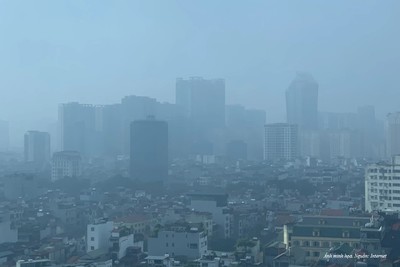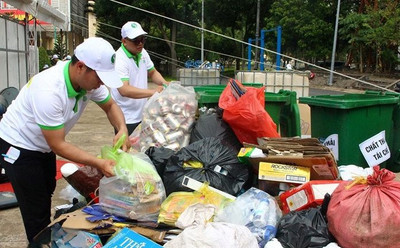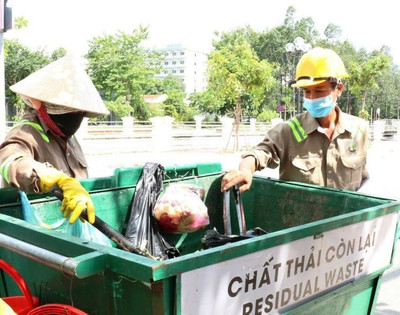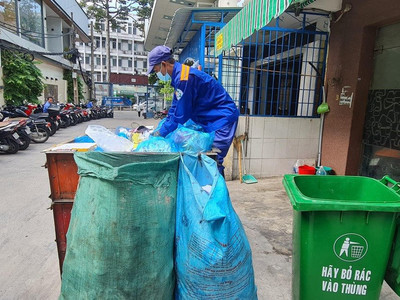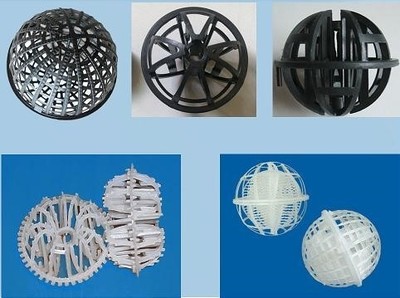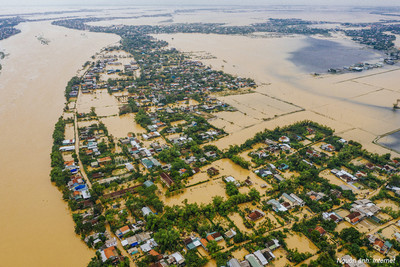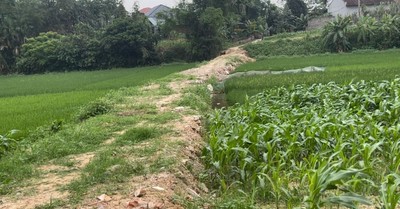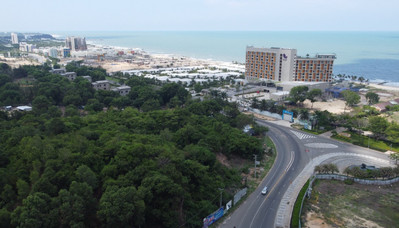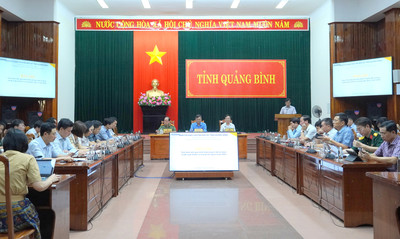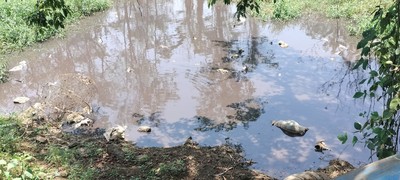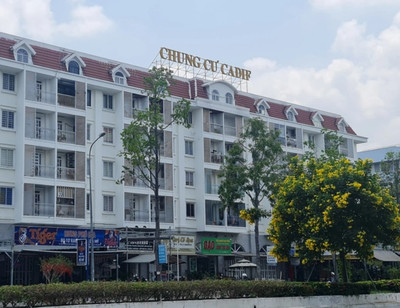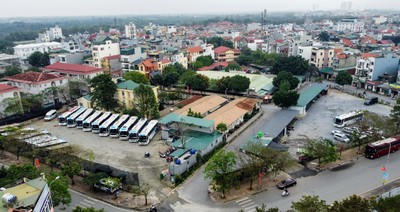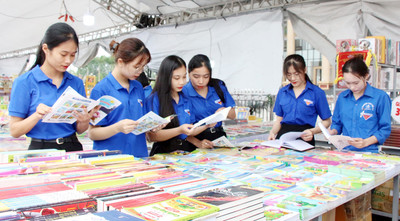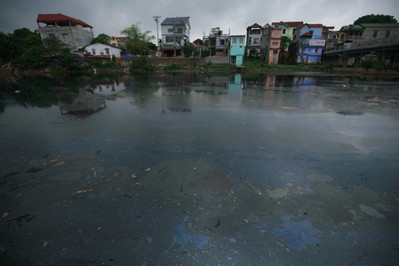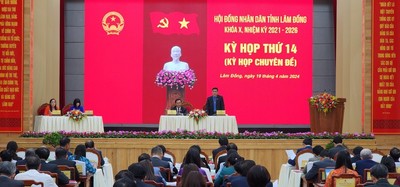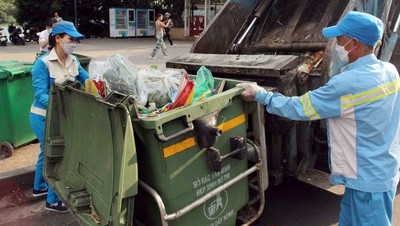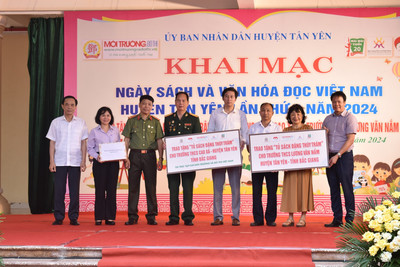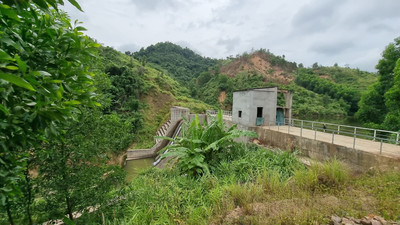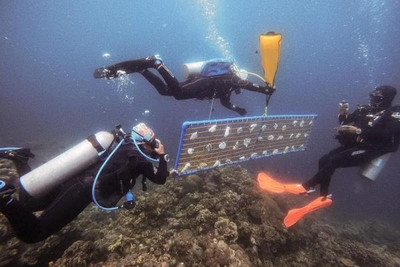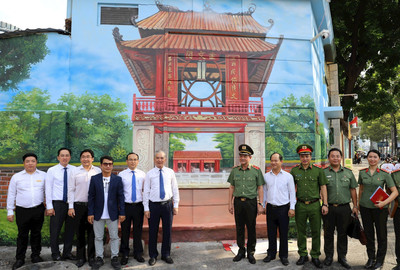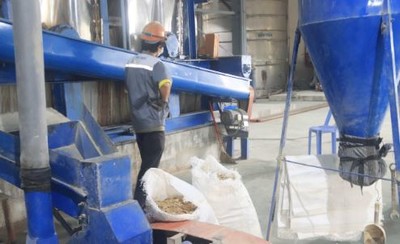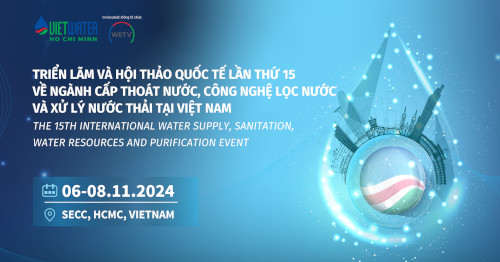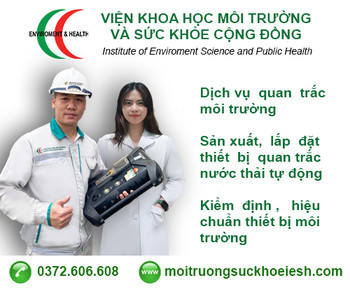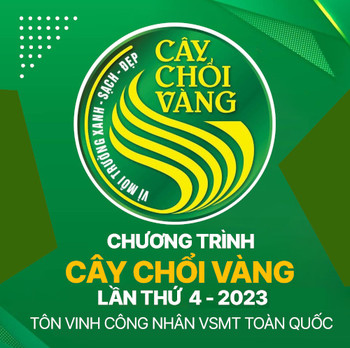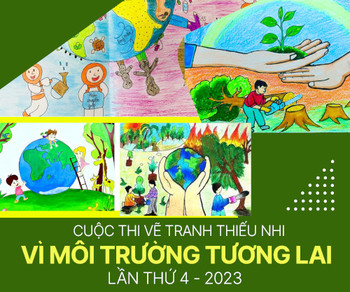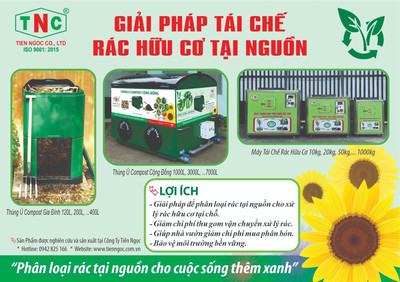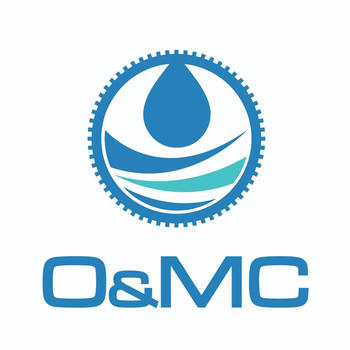Công bố quốc tế lĩnh vực môi trường số 40-2022
Trân trọng giới thiệu tới quý độc giả Công bố quốc tế lĩnh vực môi trường số 40-2022 với những nội dung chính như sau:
Về quản lý môi trường
- Tăng cường tuần hoàn tài nguyên trong xử lý nước thải: Ý nghĩa môi trường của việc nâng cấp công nghệ.
- Những thay đổi trong mô hình không gian của tần suất, thời gian và mức độ nghiêm trọng thay đổi đột ngột khô / ướt ở Trung Quốc Đại lục, 1980 - 2019.
- Giám sát hệ thống thoát nước theo dõi các đặc điểm phát thải kháng sinh của con người trong nước thải.
- Khung của những đổi mới xanh - một nghiên cứu mô hình so sánh trên khung công cộng của xe điện ở Đức và Anh.
- Tích tụ cộng sinh trong công nghiệp và tăng trưởng kinh tế xanh: Một cách tiếp cận khác biệt về không gian.
- Quản lý rủi ro tài chính xanh dựa trên dịch vụ thông minh.
- Cấu trúc của quá trình chuyển đổi năng lượng bền vững và toàn diện - Một nghiên cứu thử nghiệm.
- Phương pháp tiếp cận dựa trên dữ liệu để đánh giá khách quan về hiệu suất phát triển các-bon thấp của đô thị.
- Nghiên cứu các mô hình phát triển xây dựng nền văn minh sinh thái ở Trung Quốc: Phân tích thực nghiệm 324 thành phố cấp tỉnh.
Về môi trường đô thị
- Các nhà điều hành nhà máy xử lý nước thải báo cáo năng lực cao để hỗ trợ giám sát nước thải đối với COVID-19 trên toàn bang New York, Hoa Kỳ.
- Bón phân có phải là nguồn chủ yếu của amoniac trong bầu không khí đô thị không?
- Thành phần khối lượng, độ hòa tan, đặc điểm và các thành phần đồng vị của sắt trong than đá và tro bay chất thải đô thị.
- Giải quyết các đặc tính hấp thụ ánh sáng và các yếu tố ảnh hưởng của aerosol carbon ở Thượng Hải.
- Các dạng vi nhựa phân biệt trong trầm tích và quần xã sinh vật của dòng đô thị.
- Hóa chất trong các khu dân cư Châu Âu - Phần I: Đánh giá về lượng khí thải, nồng độ và ảnh hưởng đến sức khỏe của các hợp chất hữu cơ dễ bay hơi (VOC).
- Tác động của các biện pháp ngăn chặn SARS-CoV-2 ở miền Nam Tây Ban Nha đối với nồng độ nguyên tố vi lượng PM10 và chất ô nhiễm dạng khí.
- Phương pháp lập kế hoạch sử dụng tổng hợp tài nguyên nước đô thị dựa trên các mô hình ước tính nhu cầu nước định lượng và chỉ số điều tiết nước ngầm ở thành phố Yangon, Myanmar.
- Cảnh quan đường phố đa dạng sinh học có thể giảm thiểu tác động của tiếng ồn và ô nhiễm không khí đối với đời sống của con người không?
- Mối liên quan giữa việc tiếp xúc với các chất dạng hạt mịn và chức năng thận: Kết quả từ Khảo sát Kiểm tra Dinh dưỡng và Sức khỏe Quốc gia Hàn Quốc.
Về môi trường khu công nghiệp
- Phản ứng hóa học của các hợp chất hữu cơ dễ bay hơi và ảnh hưởng của chúng đến sự hình thành ôzôn trong khu công nghiệp hóa dầu ở Lan Châu, miền Tây Trung Quốc.
- Đánh giá rủi ro sơ bộ của các địa điểm xí nghiệp công nghiệp trong khu vực dựa trên dữ liệu lớn.
- Ứng phó của hệ sinh thái Alpine với sự nóng lên của khí hậu: Dữ liệu giám sát dài hạn của các nhà máy hóa học trên dòng suối.
- Ảnh hưởng của ngành công nghiệp hóa chất than đối với sự phát thải các hợp chất hữu cơ dễ bay hơi trong khí quyển và sự hình thành ôzôn ở một thành phố phía tây bắc Trung Quốc.
- Đặc điểm hóa học của PM2.5 trong các khu công nghiệp ô nhiễm nặng ở đồng bằng Quan Trung, tây bắc Trung Quốc.
- Nồng độ và sự phân bố của kim loại, tổng số flo, per- và poly-floalkyl (PFAS) trong mặt cắt đất thẳng đứng ở các khu vực công nghiệp.
- Ứng dụng của quá trình kết hợp điện đông và quá trình điện oxy hóa để xử lý nước thải từ ngành công nghiệp dệt bông.
- Loại bỏ acetophenone khó phân hủy khỏi nước thải công nghiệp thông qua cấu trúc nano ferit bismuth.
- Phát thải dựa trên đơn vị và tác động môi trường của các chất dạng hạt ngưng tụ công nghiệp ở Trung Quốc vào năm 2020.
- Phân bố không gian địa lý và đánh giá rủi ro sức khỏe của nước ngầm bị ô nhiễm trong các khu công nghiệp: quan điểm bền vững về môi trường.
Xin trân trọng giới thiệu!
QUẢN LÝ MÔI TRƯỜNG
1. Increasing resource circularity in wastewater treatment: Environmental implications of technological upgrades
Science of The Total Environment, Volume 838, Part 3, 10 September 2022, 156422
Abstract
A paradigm shift is needed in wastewater treatment plants (WWTPs) to progress from traditional pollutant removal to resource recovery. However, whether this transformation produces overall environmental benefits will depend on the efficient and sustainable use of resources by emerging technologies. Given that many of these technologies are still being tested at the pilot scale, there is a lack of environmental assessments quantifying their impacts and benefits. In particular, an integrated approach to energy and nutrient recovery can elucidate the potential configurations for WWTPs. In this study, we conduct a life cycle assessment (LCA) of emergent wastewater treatment technologies aimed at increasing resource circularity in WWTPs. We focus on increasing energy self-sufficiency through biogas upgrades and a more radical circular approach aimed at nutrient recovery. Based on a case-study WWTP, we compare its current configuration with (1) implementing autotrophic nitrogen removal in the mainstream and deriving most of the organic matter for biogas production, which increases the quality and quantity of biogas available for energy production; (2) implementing struvite recovery through enhanced biological phosphorus removal (EBPR) as a radical approach to phosphorus management, offering an alternative to mineral fertilizer; and (3) a combination of both approaches. The results show that incremental changes in biogas production are insufficient for compensating for the environmental investment in infrastructure, although autotrophic nitrogen removal is beneficial for increasing the quality of the effluent. Combined phosphorus and energy recovery reduce the environmental impacts from the avoided use of fertilizers and phosphorus and the nitrogen release into water bodies. An integrated approach to resource management in WWTPs is thus desirable and creates new opportunities toward the implementation of circular strategies with low environmental impact in cities.
2. Changes in the spatiotemporal patterns of dry/wet abrupt alternation frequency, duration, and severity in Mainland China, 1980-2019
Science of The Total Environment, Volume 838, Part 3, 10 September 2022, 156521
Abstract
Changes in extreme events have received increasing attention in the context of climate change. Extreme changes in wet and dry events due to changes in meteorological elements, such as the spatial and temporal redistribution of precipitation and temperature increases, are extreme weather events that have attracted much attention in recent years. In contrast, there is a relative lack of research on extreme compound events that focuses on a transition between wet and dry spells in adjacent months. This paper provides maps of the frequency, duration, and severity of national-scale dry wet abrupt alternation (DWAA) events for 1980–1999 and 2000–2019, aiming to obtain information regarding events in the hotspot areas of DWAA in China during the past four decades in order to analyze their change patterns. This paper performs station-based standardized precipitation evapotranspiration index (SPEI) calculations to characterize local wet and dry spells based on meteorological observations provided by the China Meteorological Administration (CMA) since 1980 with regional analyses based on seven geographic divisions of China. Our finding explicitly discloses the "more-less-more” DWAA variation pattern from North to South China. Additionally, the changes in frequency, duration, and severity in the different regions are revealed. The frequency, duration, and severity of Dsingle bondW increased from 5.08 to 6.74, 17.71 to 24.62, and 12.51 to 17.01, respectively, an increase of 32.53%, 39.04% and 36.01%, while the corresponding Wsingle bondD only increased by 9.45%, 15.22% and 13.51%. In addition, events with a higher severity of DWAA are prone to appear in most regions due to the increasing interval between heavy rainfall and the increase in precipitation under global warming.
3. Climatology and changes in hourly precipitation extremes over China during 1970-2018
Science of The Total Environment, Volume 839, 15 September 2022, 156297
Abstract
Sub-daily precipitation extremes could intensify with temperature at a higher rate than the scaling for daily precipitation extremes, posing increasing risks to natural ecosystem and human society in the era of global warming. A systematic investigation of the climatology and spatiotemporal changes in sub-daily precipitation extremes is of paramount importance to inform future precipitation projection as well as to guide climate adaptation. Here, leveraging a newly proposed set of sub-daily extreme precipitation indices, we examine the climatology and changes in hourly precipitation extremes in mainland China across the major river basins during the warm period of 1970–2018. Our results show that the southern and eastern parts of China tend to experience more frequent hourly precipitation extremes with larger intensity, and the Pearl river basin has the most frequent and intense extreme precipitation at hourly timescale. The Southeast and Yangtze river basins and the mainland China as a whole have field significantly increasing trends in average and extreme precipitation intensities as well as in extreme precipitation frequencies. The intensification signals in hourly precipitation extremes of mainland China seem to emerge from internal climate variability around 2010, whereas average precipitation intensity since 1970 could become field significant earlier than 1999. Besides, we note a marked shift in the probability distributions of the extreme indices, with a wetting tendency toward more frequent and more intense precipitation extremes from the 1970–1999 period to the recent two decades in the 21st century. Our findings provide an alternative line of evidence for changes in precipitation extremes at hourly timescale over China and could contribute to societal decision-making for climate adaptation.
4. Sewerage surveillance tracking characteristics of human antibiotic emission in sewage
Journal of Cleaner Production, Volume 364, 1 September 2022, 132479
Abstract
Antibiotics discharging are causing the concerns of public health and sustainable production. Further policies on antibiotic production and antibiotic sales are difficult to make when lacking of sewage surveillance. In this study, the dynamic occurrence of 24 typical antibiotics in urban sewerage was investigated throughout a whole year. It was found that 17 of 42 samples had a total antibiotic concentration of more than 1000 ng/L. Sulfonamides, lincosamides, macrolides and tetracyclines were the four most common antibiotic categories in sewerage system, with the average concentration of 1246 ng/L, 2418 ng/L, 1734 ng/L and 1140 ng/L, respectively. The concentration of β-lactams was relatively low in the raw sewage (with the median value of 11 ng/L) and exhibited a tendency of attenuation in sewerage due to its degradability. The total concentration of antibiotics in sewage in different quarters were positively correlated with the dosage of antibiotics prescribed by local hospitals (R = 0.88, p < 0.01). The antibiotics profiles were also determined by the local regional discharge, specific seasons and weather features. Antibiotics consumption significantly affects the level of antibiotic residues in sewage, indicating that sewage surveillance can provide rough information on antibiotic usage. These findings can lead to new ways to understand the actual antibiotic usage in humans, and guide the antibiotic production and usage based on sewage surveillance.
5. The framing of green innovations-a comparative topic modeling study on the public frames of the electric vehicle in Germany and UK
Journal of Cleaner Production, Volume 364, 1 September 2022, 132499
Abstract
In the innovation framing literature, scholars argue that green innovations are being challenged by legitimacy barriers associated with strong lock-in effects on the fossil-based economy. To break down barriers and create legitimacy, we stress the role of demarcation frames. Demarcation frames we argue are an important supplement to the established framing mechanisms that signal alignment and similarity with existing systems. Building on a machine-learning topic modeling approach, we investigate the development of the perception and meaning of the electric vehicle over a period of 27 years-i.e., its framing. By using public media data to undertake a systematic cross-country study in Germany and the UK, we show how and through which combinations of framing mechanisms the electric vehicle overcame the initial skepticism that was closely linked to the internal combustion vehicle. Hence, our research contributes to a better understanding of the framing processes around green innovations in the carbon-based economy. Firstly, we offer a novel analytical perspective focusing on the overarching public framing of green innovations. Secondly, we contribute to the literature by describing the theoretical implications and functionality of demarcation frames to overcome lock-ins. And thirdly, we discuss policy implications to support the dissemination of green innovations and propose future research avenues relevant for the green innovation and innovation framing field.
6. Industrial symbiotic agglomeration and green economic growth: A spatial difference-in-differences approach
Journal of Cleaner Production, Volume 364, 1 September 2022, 132560
Abstract
As a new form of industrial organization, there is still a lack of research on how industrial symbiotic agglomeration affects green economic growth. To fill this research gap, this paper analyzes the impact mechanism of industrial symbiotic agglomeration on green economic growth from the perspective of energy efficiency, waste recycling, and green technology innovation. Based on the data of Chinese cities from 2004 to 2019, we use the spatial difference-in-differences approach for empirical testing. The research concludes: (1) Industrial symbiotic agglomeration can both significantly promote green economic growth and have a spillover effect on neighboring cities. (2) The specific spillover effects are divided into three cases. Diffusion effect (within 150 km), siphon effect (150 km–750 km), no significant spatial effect (over 750 km). (3) The promotion and spillover effects of industrial symbiotic agglomeration on green economic growth can only be brought into full play when a certain threshold is reached. The local promotion effect requires the area of the symbiotic agglomeration area to be greater than 106 km2, while the spillover effect requires a larger scale (greater than 393.2 km2) for it to manifest itself. This has theoretical and practical significance for promoting green growth and achieving sustainable development through symbiotic agglomeration.
7. Green financial risk management based on intelligence service
Journal of Cleaner Production, Volume 364, 1 September 2022, 132617
Abstract
Risk management is an important issue of green finance, and it is also a prominent issue of green economic development. The resolution of green financial risk will help protect the interests of all stakeholders and promote the development of green finance. This study suggests that intelligence service provides new ideas and ways for green financial risk management. Applying intelligence service to green financial risk management will contribute to the sustainable development of green finance and enrich the theoretical system of intelligence science. This study first builds an intelligence service system of green financial risk management from five aspects: intelligence demand, intelligence collection, intelligence processing, intelligence application, and intelligence tracking. A questionnaire is designed based on this system. The first batch of green finance pilot cities in China (Ganjiang, Gui'an, Guangzhou, Huzhou, Quzhou, Changji, Hami, and Karamay) are investigated. This study uses a regression model to analyze the data and analyzes the intelligence service status of green financial risk management in pilot cities. The research divides those green finance pilot cities into eastern, central, and western regions. It shows obvious differences in the intelligence service elements in the eastern, central, and western regions of green financial risk management. The eastern region pays more attention to the three elements of intelligence demand, intelligence application, and intelligence tracking when carrying out green financial risk management. In the process of green financial risk management in the western region, there are obvious deficiencies in the two elements of intelligence collection and intelligence processing, which may be due to the lack of advanced digital equipment and effective digital resource. The central region lies between the eastern and western regions on intelligence service of green financial risk management. Based on the above results, this study proposes that establishing an intelligence center, sharing intelligence resources, improving digital technology, and updating intelligence cases can enhance the effectiveness of intelligence service in the risk management of green finance.
8. Co-recycling of natural and synthetic carbon materials for a sustainable circular economy
Journal of Cleaner Production, Volume 365, 10 September 2022, 132674
Abstract
Circular economy approaches are commonly depicted by two cycles, where the biological cycle is associated with regeneration in the biosphere and the technical cycle with reuse, refurbishment, and recycling to maintain value and maximize material recovery. This work, instead, presents an alternative vision to the management of carbon-based materials that integrates the two cycles and enables the phasing-out of fossil carbon from the material system. The aim is to investigate the benefits and global potential of a co-recycling system, as an alternative to conventional recycling systems that separate biomass-based materials (e.g., wood, paper) from fossil-based materials (e.g., plastics). Thermochemical recycling technologies enable the conversion of carbon-based waste materials into high-quality synthetic products, promoting circularity and avoiding carbon losses such as carbon emissions and waste accumulation in landfills and nature. Here, the construction and analysis of co-recycling scenarios show how the deployment of thermochemical recycling technologies can decouple the material system from fossil resource extraction. Furthermore, energy use is reduced if pyrolysis and/or gasification are included in the portfolio of recycling technologies. In a decarbonized energy system, deployment of co-recycling can lead to near-zero carbon emissions, while in more carbon-intensive energy systems the choice of thermochemical recycling route is key to limiting carbon emissions.
9. Structuring the problem of an inclusive and sustainable energy transition – A pilot study
Journal of Cleaner Production, Volume 365, 10 September 2022, 132763
Abstract
The purpose of the article is to contribute to structuring the problem of how to advance a sustainable energy transition and achieve carbon neutrality goals while ensuring a democratic and inclusive process, by drawing on a pilot case – i.e., the energy transition in Portugal. By building on approaches and concepts from the Sustainability Transitions research field, the article explores perceptions, values, and concerns regarding distributed and centralized energy models; inclusivity and energy democracy; energy systems’ sustainability concerns and the speed of the transition. The study draws on the hypothesis that stakeholders across the state, market, community and third sector spheres, while equally supporting decarbonization, have different perceptions, values, and concerns regarding the social, environmental, and technological dynamics of the energy transition that need to be better understood for accelerating the transition. The multi-method approach included interviews, a survey (N = 110) and a stakeholder workshop, to unpack the key values and preferences around energy system technologies, sustainability and inclusionary aspects, the role of centralized and distributed energy systems and new investments, namely in green hydrogen and lithium mining. The results indicate there is a significant convergence on the fact that decarbonization is a priority that needs to be supported by inclusive and democratic processes. Decentralization, energy communities and solar energy are extremely valued, and transparency and information sharing are crucial expectations for new lithium mining projects, large-scale solar and green hydrogen investments. These findings outline some avenues for future research, where participation and transparency become anchors for a sustainable and inclusive transition.
10. Does resource environment carrying capacity have a coercive effect on urbanization quality? Evidence from the Yangtze River Economic Belt, China
Journal of Cleaner Production, Volume 365, 10 September 2022, 132612
Abstract
Understanding the relationship between resource environment carrying capacity (RECC) and urbanization quality (UQ) is of great significance for the new urbanization strategy. Different from previous studies which mainly focused on the coordination degree between urbanization and RECC, this study explores the environmental Kuznets curve relationship between UQ and RECC pressure by considering the nonlinear relationship between systems. The 11 sub-regions in the Yangtze River Economic Belt of China are selected as the study area. Results show that: (1) All 11 sub-regions witness UQ growth during the survey period of 2005–2017, among which Shanghai, Jiangsu, and Zhejiang take the three top positions. (2) The levels of RECC in the 11 sub-regions follow a gradual increasing trend from 2005 to 2017. Shanghai has the highest RECC value, and Guizhou province has the lowest RECC. (3) Except for Zhejiang, the other three sub-regions downstream of the Yangtze River present an N-shaped relationship between UQ and RECC pressure. The relationship for the three midstream regions presents a U shape, while that for upstream regions is either a U shape or an inverted N shape. These findings provide a valuable reference for governments to formulate effective measures for promoting the coordination of UQ and RECC in the Yangtze River Economic Belt. Moreover, new insights for conducting research on the relationship between UQ and RECC in other economic systems on a global level are given.
11. Predicting the environmental economic dispatch problem for reducing waste nonrenewable materials via an innovative constraint multi-objective Chimp Optimization Algorithm
Journal of Cleaner Production, Volume 365, 10 September 2022, 132697
Abstract
The usage of conventional fossil fuels has aided fast economic growth while also having negative consequences, such as increased global warming and the destruction of the ecosystem. This paper proposes a novel swarm-based metaheuristic method called Chimp Optimization Algorithm (ChOA) to tackle the environmental, economic dispatch issue and reducing the waste nonrenewable materials. In this regard, two objective functions named fuel cost function and emission cost function are proposed. Unique constrained handling also solves the challenge of multi-objective optimization. Standard IEEE 30 bus with six generators and a 10-unit system are used to demonstrate the usefulness of ChOA. The result of ChOA is compared with Individual Best Memory Penalty Factor Grey Wolf Optimizer (IBMPF-GWO), Improved Whale Trainer (IWT), Chaotic Biogeography-Based Optimizer (CBBO), Non-Linear Migration BBO (NLBBO), Hybrid Gravitational Search Algorithm Particle Swarm Optimization (GSAPSO), Covariance Matrix Adaptation Evolution Strategy (CMA-ES), Differential Evolution-Crossover Quantum Particle Swarm Optimization (DE-CQPSO), Salp Swarm Algorithm (SSA), Dragonfly Algorithm (DA), and Fuzzy Grasshopper Optimization Algorithm (FGOA) to confirm its efficiency. For both single- and multi-objective optimization, ChOA's assessment index and convergence rate are superior to other benchmark algorithms, regardless of whether the goal is to reduce emissions or to reduce fuel costs. The efficacy and robustness of the ChOA in handling environmental economic dispatch problems have been shown by discovering a good compromise value.
12. Does the carbon emission trading scheme boost corporate environmental and financial performance in China?
Journal of Cleaner Production, Volume 368, 25 September 2022, 133151
Abstract
Carbon emission trading, a market-incentive environmental regulation, plays a critical role in leading China towards the carbon peaking and carbon neutrality. To improve the national carbon emission trading in China, we analyze the effects of the policy in pilot provinces and pilot A-share listed firms from 2008 to 2016. Particularly, to explore the pilot policy's environmental and financial impacts, this paper applies a difference-in-difference method. After the robustness check, the results confirm the carbon emission trading pilot's significantly positive impact at both firm- and province-level regarding carbon emission reduction. Meanwhile, corporate innovation seems to partially mediate the relationship between the policy and corporate carbon emission reduction. Plus, the policy promotes firms' market-based financial performance but such impact on accounting-based financial performance is insignificant. Ultimately, the operational mechanism of the policy is proved to be effective. In this paper, industry- and firm-level carbon emissions databases are established via environmental extended input-output table, which fill the research gap of China's firm-level carbon emissions. To ensure the reliability of results, the list of covered firms is sorted out manually in accordance with the disclosed data of seven carbon trading markets. Our results are meaningful for avoid productivity reduction and mechanism re-design in the context of the national carbon emission trading launched in 2021. Specifically, encouraging firms to further improve their productivity and competitiveness by innovation could eventually achieve a win-win situation between economic performance and environmental merits in the long run.
13. A data-driven approach to objective evaluation of urban low carbon development performance
Journal of Cleaner Production, Volume 368, 25 September 2022, 133238
Abstract
An effective evaluation of a city's low carbon development plays an essential role in promoting low carbon development strategies for achieving the city's sustainable development. This paper proposes a data-driven approach to objectively evaluating the low carbon development level of cities. The approach formulates the low carbon development evaluation problem as a multi-criteria decision analysis problem and incorporates the merits of bibliometric analysis, text mining and optimal weighting to evaluating the urban low carbon development performance. The bibliometric analysis is applied to systematically identify evaluation criteria and associated indicators and establish an evaluation system for measuring low carbon development levels of urban cities. Equipped with an objective weighting method based on text mining, the approach determines the local weights of the evaluation criteria and indicators for each city by extracting subjective preferential information from the policy documents available on the local government's websites. Two optimal weighting models are developed to determine the optimal global weights of the indicators and criteria by maximizing the low carbon development performance of all cities. The obtained criteria weighting thus can reflect both the preferences of local city governments and the best common interest of all cities involved in the evaluation. The approach is then illustrated with a case study on three cities involved in urban agglomeration planning in China. The results compare the low carbon development performance of the cities, identify the disparities between the cities and reveal each city's obstacle factors that hinder its development. Policy recommendations are then suggested for developing effective low carbon development policies.
14. Study on the development patterns of ecological civilization construction in China: An empirical analysis of 324 prefectural cities
Journal of Cleaner Production, Volume 367, 20 September 2022, 132975
Abstract
Ecological civilization construction is a task of paramount importance for China's sustainable development. To explore the performance and development patterns of ecological civilization construction in China, this study established an indicator system to evaluate the ecological civilization construction at the city-level. A double-benchmark progressive method and the key functional zone weighting assignment were used to improve the evaluation process. On this basis, this study analyzed the levels of ecological civilization construction and its changes in 324 prefecture-level cities in mainland China from 2015 to 2019. Furthermore, criteria for classifying the development patterns of ecological civilization construction were proposed based on the socio-economic development and eco-environmental performance of cities. According to the findings: (1) China's ecological civilization construction had made great progress with the scores increase of approximately 8%. The score of China was 71 in 2019 and more than half of the evaluated cities scored higher than 70. (2) Cities under "harmonious coexistence” (both economy and environment performing well) and "antagonistic development” (economy developing with environment requiring improvement) patterns accounted for the highest proportion with a total of 62%. The proportion of cities under the "harmonious coexistence” pattern constantly increased, while that of cities under the "antagonistic development” pattern declined 28% from 2015 to 2019. This study analyzed the patterns of China's ecological civilization construction in prefecture-level cities, providing a mode for green and sustainable development of areas with different natural endowments.
15. Projections of urban built-up area expansion and urbanization sustainability in China's cities through 2030
Journal of Cleaner Production, Volume 367, 20 September 2022, 133086
Abstract
In the context of socioeconomic initiatives to address world development sustainability such as the Sustainable Development Goals (SDGs), China's urbanization with increasing intensity and quickening pace has always been central to debates over the past few decades. Although the United Nations (UN) recommend to estimate and predict the local-scale urbanization sustainability by using the SDG indicator 11.3.1: "ratio of land consumption rate to population growth rate (LCRPGR)”, there remains a lack of reliable projections and applicable assessments at the city level, especially for the future urban expansion. Until now, limited knowledge of the urbanization sustainability dynamics in the next decade has been the primary challenge to inform the realization of urban sustainable development goal under the framework of SDGs. To evaluate the geographic region- and population size-specific urbanization sustainability at the city level in mainland China between 2020 and 2030, an integrated downscaling approach of trend extrapolation and regression analysis was developed based on historical statistics of urban built-up area and subnational scenarios of population and gross domestic product (GDP) under the Shared Socioeconomic Pathways (SSPs). The SSPs-consistent urban built-up area projections across different scales showed that the logistic regression had a better modeling performance than the panel data regression, while there was little difference between the linear and exponential extrapolation methods. Despite the geographical heterogeneity and size-related disparity, the scenario modeling results suggested that the average value of LCRPGR indicator in mainland China was expected to decline continuously, and would reach at the ideal state with a coordination between urban expansion and population growth through 2030. Specifically, the population growth stagnation of cities in Northeast China and the allometric urban expansion of cities in Western China should be the focus of strengthened regulations, and the urban growth of megacities would experience a steady and slower trend compared to their surrounding super-large cities and large cities. In summary, China's urbanization process might have headed toward a more sustainable and coordinated future under feasible SSPs scenarios. The local-scale forecasts will not only fill the data gap of SSPs-consistent urban land demand for all county- and prefecture-level cities in mainland China, but can also provide a reference for forecasting and assessment of urbanization sustainability to meet the SDGs in urban areas such as indicator 11.3.1.
MÔI TRƯỜNG ĐÔ THỊ
1. The rapid spread of SARS-COV-2 Omicron variant in Italy reflected early through wastewater surveillance
Science of The Total Environment, Volume 837, 1 September 2022, 155767
Abstract
The SARS-CoV-2 Omicron variant emerged in South Africa in November 2021, and has later been identified worldwide, raising serious concerns.
A real-time RT-PCR assay was designed for the rapid screening of the Omicron variant, targeting characteristic mutations of the spike gene. The assay was used to test 737 sewage samples collected throughout Italy (19/21 Regions) between 11 November and 25 December 2021, with the aim of assessing the spread of the Omicron variant in the country. Positive samples were also tested with a real-time RT-PCR developed by the European Commission, Joint Research Centre (JRC), and through nested RT-PCR followed by Sanger sequencing.
Overall, 115 samples tested positive for Omicron SARS-CoV-2 variant. The first occurrence was detected on 7 December, in Veneto, North Italy. Later on, the variant spread extremely fast in three weeks, with prevalence of positive wastewater samples rising from 1.0% (1/104 samples) in the week 5–11 December, to 17.5% (25/143 samples) in the week 12–18, to 65.9% (89/135 samples) in the week 19–25, in line with the increase in cases of infection with the Omicron variant observed during December in Italy. Similarly, the number of Regions/Autonomous Provinces in which the variant was detected increased from one in the first week, to 11 in the second, and to 17 in the last one. The presence of the Omicron variant was confirmed by the JRC real-time RT-PCR in 79.1% (91/115) of the positive samples, and by Sanger sequencing in 66% (64/97) of PCR amplicons.
In conclusion, we designed an RT-qPCR assay capable to detect the Omicron variant, which can be successfully used for the purpose of wastewater-based epidemiology. We also described the history of the introduction and diffusion of the Omicron variant in the Italian population and territory, confirming the effectiveness of sewage monitoring as a powerful surveillance tool.
2. Wastewater treatment plant operators report high capacity to support wastewater surveillance for COVID-19 across New York State, USA
Science of The Total Environment, Volume 837, 1 September 2022, 155664
Abstract
Wastewater surveillance for infectious disease expanded greatly during the COVID-19 pandemic. As a collaboration between sanitation engineers and scientists, the most cost-effective deployment of wastewater surveillance routinely tests wastewater samples from wastewater treatment plants. To evaluate the capacity of treatment plants of different sizes and characteristics to participate in surveillance efforts, we developed and distributed a survey to New York State municipal treatment plant supervisors in the summer and fall of 2021. The goal of the survey was to assess the knowledge, capacity, and attitudes toward wastewater surveillance as a public health tool. Our objectives were to: (1) determine what treatment plant operators know about wastewater surveillance for public health; (2) assess how plant operators feel about the affordability and benefits of wastewater surveillance; and (3) determine how frequently plant personnel can take and ship samples using existing resources. Results show that 62% of respondents report capacity to take grab samples twice weekly. Knowledge about wastewater surveillance was mixed with most supervisors knowing that COVID-19 can be tracked via wastewater but having less knowledge about surveillance for other public health issues such as opioids. We found that attitudes toward wastewater testing for public health were directly associated with differences in self-reported capacity of the plant to take samples. Further, findings suggest a diverse capacity for sampling across sewer systems with larger treatment plants reporting greater capacity for more frequent sampling. Findings provide guidance for outreach activities as well as important insight into treatment plant sampling capacity as it is connected to internal factors such as size and resource availability. These may help public health departments understand the limitations and ability of wastewater surveillance for public health benefit.
3. Is fertilization the dominant source of ammonia in the urban atmosphere?
Science of The Total Environment, Volume 838, Part 1, 10 September 2022, 155890
Abstract
It was previously believed that ammonia (NH3) has a short residence time in the atmosphere and cannot be transported far from its sources. In late March, however, this study observed a severe NH3 episode in urban Beijing when fertilizer was intensively applied on the North China Plain, with the highest hourly concentrations of 66.9 μg m−3 throughout the year. The stable nitrogen isotopic composition of NH3 (δ15N–NH3) during this episode (−37.0 to −20.0‰) fell in the range of endmembers of fertilizer and livestock, suggesting the long-range transport of NH3 from agricultural to urban regions. Based on a Bayesian isotope mixing model, the contribution of agriculture (fertilization) to urban NH3 concentrations was apportioned as 43.5% (26.0%) on polluted days. However, these contributions were reduced to 29.1% (12.8%) when nitrogen isotope fractionation between NH3 and ammonium was considered. In contrast to the limited contribution of agricultural sources, we found that nonagricultural emissions, particularly vehicles, dominate the source of NH3 in urban Beijing, even during the fertilization period. This finding indicated that nonagricultural sources should be considered when designing a control strategy for NH3 to reduce haze pollution in the urban atmosphere.
4. Particulate matter exposure at urban traffic intersection during haze episodes: A case study in Changsha
Science of The Total Environment, Volume 838, Part 1, 10 September 2022, 156006
Abstract
Urban intersection has been identified as a major contributor to the total personal exposure and short-term high exposure of particulate matter (PM) in modern cities. The main aim of this study was to get a better understanding of the determinants of traffic-related PM temporal variations and personal exposure to PMs at a viaduct-covered intersection controlled by traffic signals during the winter haze episodes. A two-day field sampling campaign was conducted with a portable device during evening rush hour and measured the PMs in the 0.3–10 μm size range both on the surface crosswalk and underground passage. PM variations and related cumulative respiratory deposition dose (RDD) along two routes with six road crossing scenarios were estimated on a severe pollution day and a typical day for both adults and children, respectively. The PM concentration on the severe pollution day ranged 59.2–67.9 μg/m3 for PM1, 163.8–257.0 μg/m3 for PM2, and 258.2–469.1 μg/m3 for PM10, respectively, as compared to 47.9–57.9 μg/m3for PM1, 112.7–199.8 μg/m3 for PM2, and 151.0–301.0 μg/m3 for PM10 on the typical day, respectively. The variability could be explained largely by the built-up environment, traffic component, signal setting, and ventilation condition. Our data suggest that an appropriate setting of the traffic signal would help reduce the personal exposure dose on the surface crosswalk at urban intersections and the ventilation condition had a significant influence on local PM distributions inside the underground passage. Results here provide possible suggestions for the future design of a walkable city.
5. Mass fractions, solubility, speciation and isotopic compositions of iron in coal and municipal waste fly ash
Science of The Total Environment, Volume 838, Part 1, 10 September 2022, 155974
Abstract
Deposition of anthropogenic aerosols may contribute significantly to dissolved Fe in the open ocean, affecting marine primary production and biogeochemical cycles; however, fractional solubility of Fe is not well understood for anthropogenic aerosols. This work investigated mass fractions, solubility, speciation and isotopic compositions of Fe in coal and municipal waste fly ash. Compared to desert dust (3.1 ± 1.1%), the average mass fraction of Fe was higher in coal fly ash (6.2 ± 2.7%) and lower in municipal waste fly ash (2.6 ± 0.4%), and the average Fe/Al ratios were rather similar for the three types of particles. Municipal waste fly ash showed highest Fe solubility (1.98 ± 0.43%) in acetate buffer (pH: 4.3), followed by desert dust (0.43 ± 0.30%) and coal fly ash (0.24 ± 0.28%), suggesting that not all the anthropogenic aerosols showed higher Fe solubility than desert dust. For the samples examined in our work, amorphous Fe appeared to be an important controlling factor for Fe solubility, which was not correlated with particle size or BET surface area. Compared to desert dust (−0.05‰ to 0.21‰), coal and municipal waste fly ash showed similar or even higher δ56Fe values for total Fe (range: 0.05‰ to 0.75‰), implying that the presence of coal or municipal waste fly ash may not be able to explain significantly smaller δ56Fe values reported for total Fe in ambient aerosols affected by anthropogenic sources.
6. Distinct microplastic patterns in the sediment and biota of an urban stream
Science of The Total Environment, Volume 838, Part 3, 10 September 2022, 156477
Abstract
Urban freshwaters, their sediments and resident biota are often highly susceptible to microplastic contamination from catchment-specific sources. Water velocity and spatiotemporal dynamics within the system can impact microplastic loads, while biological features may additionally impact levels within freshwater biota. Here, we investigated the spatiotemporal variations in microplastic loads collected from sediment, macroinvertebrate and fish samples from an urban watercourse (Bourne Stream) in Dorset, southwest England. Sediment particles were mostly fragments of colours (especially orange and purple) whereas microplastics in both macroinvertebrates and fishes were blue/green and fibres. Across all sample types, the dominant particle size class was ≤100 μm. Median (M) and range (R) of microplastic loads within each sample type were sediment: M = 0.06, R = 0–0.36 particles g−1; macroinvertebrates: M = 0, R = 0–4 particles per batch; and fishes: M = 1, R = 0–6 particles per individual. Sediment loads varied spatially, with the highest load in the most upstream site, whereas biotic loads did not vary across space and time. Macroinvertebrate batch loadings varied between taxa and feeding guild, with counts significantly higher in annelids but lower in herbivores. Fish counts were higher in species with true, differentiated stomachs, but with the effects of species, feeding guild and body size being non-significant. Within sites, mean microplastic loads did not correlate between sediment, macroinvertebrate and fish samples. These results suggest that sediment freshwater microplastic loadings may vary spatially but that these trends are not reflected by, or correlated to, those in the biota where ingestion varies with biological traits. Assessments of freshwater microplastic contamination must therefore consider sampling spatiotemporally and across different biotic communities to fully understand the scale of contamination, and to subsequently undertake effective mitigation steps.
7. Seasonal changes in the recent decline of combined high PM2.5 and O3 pollution and associated chemical and meteorological drivers in the Beijing-Tianjin-Hebei region, China
Science of The Total Environment, Volume 838, Part 3, 10 September 2022, 156312
Abstract
China suffers from combined air pollution (CAP) comprising dual high O3 and PM2.5, particularly in the Beijing–Tianjin–Hebei (BTH) region, which is an urban agglomeration in the North China Plain. To characterize the seasonal changes in regional CAP, 82 CAP days were identified during the study period from 2015 to 2019 with the co-occurring pollution of O3 and PM2.5 in the BTH. It is found that CAP seasonality has undergone distinct changes with a declining trend in the interannual variations in CAP over recent years. It is also revealed that the monthly CAP peaks have recently shifted from summer to early spring (March and April), indicating seasonal changes in CAP in the BTH. Furthermore, the of chemical and meteorological roles in CAP changes was investigated using environmental and meteorological observation data. The recent reduction in PM2.5 and O3 concentrations had enhanced O3 production and atmospheric oxidizability, thereby causing increments in secondary PM2.5 proportion. The interaction between O3 and PM2.5 was responsible for changing the CAP of dual high O3 and PM2.5 to the transition/spring season in the context of mitigation of air pollutant emissions. Furthermore, principal component analysis in the T-mode (T-PCA) was applied to identify four synoptic circulation patterns that regulate CAP occurrence. The results show that the CAP occurrence was regulated by the dominant patterns of synoptic circulation in the BTH. Warm temperature and strong downward ultraviolet radiation anomalies were observed in the BTH, indicating the importance of meteorological drivers in O3 photochemical production on the CAP. The frequency of key synoptic circulation patterns during the spring season increased annually, thereby inducing seasonal changes in the atmospheric environment with CAP in the BTH in recent years.
8. Deconvolving light absorption properties and influencing factors of carbonaceous aerosol in Shanghai
Science of The Total Environment, Volume 839, 15 September 2022, 156280
Abstract
Black carbon (BC) and brown carbon (BrC) have intensive impacts on atmospheric visibility and global climate change. In this study, PM2.5 samples were collected at Pudong (PD) and Qingpu (QP) of Shanghai in 2017, and characterized typical organic molecular tracers by gas chromatography-mass spectrometer. The light absorption (Abs) of carbonaceous aerosol and water-soluble organic matter was analyzed by a multi-wavelength thermal/optical carbon analyzer. and a long-range ultraviolet-visible spectrophotometer. An improved two-component model integrated with both optical and chemical fingerprints of carbonaceous aerosol was applied to analyze the Abs of BC, water-soluble organic carbon (WSOC) and water-insoluble organic carbon (WISOC), with which the potential influencing factors including emission source and atmospheric aging were investigated. Results indicated that BrC contributed 19% at PD and 16% at QP of the total light absorption of the carbonaceous aerosol at 405 nm wavelength. Meanwhile, AbsWSOC(405)/AbsBrC (405) showed significant seasonal variations (27–50%) at both sites. Positive matrix factorization (PMF) analysis showed that vehicle emissions (60–61%) and biomass combustion (38–39%) were the major contributors to AbsBC (405), while biomass burning (34–40%), nitrate-relevant secondary processes (22–23%), vehicle emissions (18–19%) and biogenic SOA (13–19%) were major contributors to AbsWSOC(405). Hybrid combustion source (94–96%) had a predominant contribution to AbsWISOC(405). Statistical analysis showed that biomass burning had a great impact on the enhancement of AbsWISOC. Absorption Ångström exponent (AAE) and mass absorption efficiency (MAE) of each factor (source) using PMF analysis indicated that WSOC from combustion sources had higher AAEWSOC(350–550) values (8.11 and 8.29 for coal and biomass burning, respectively) and MAEWSOC(365) values (0.63–0.99) compared to other sources. Atmospheric aging process can lower the MAEWSOC(365) value (0.24–0.52). Overall, our study facilitates a better understanding of the relationships among source, optical properties, and atmospheric transformation processes of the carbonaceous aerosols in Shanghai.
9. Chemicals in European residences - Part I: A review of emissions, concentrations and health effects of volatile organic compounds (VOCs)
Science of The Total Environment, Volume 839, 15 September 2022, 156201
Abstract
One of the more important classes of potentially toxic indoor air chemicals are the Volatile Organic Compounds (VOCs). However, due to a limited understanding of the relationships between indoor concentrations of individual VOCs and health outcomes, there are currently no universal health-based guideline values for VOCs within Europe including the UK. In this study, a systematic search was conducted designed to capture evidence on concentrations, emissions from indoor sources, and health effects for VOCs measured in European residences.
We identified 65 individual VOCs, and the most commonly measured were aromatic hydrocarbons (14 chemicals), alkane hydrocarbons (9), aldehydes (8), aliphatic hydrocarbons (5), terpenes (6), chlorinated hydrocarbons (4), glycol and glycol ethers (3) and esters (2). The pathway of interest was inhalation and 8 individual aromatic hydrocarbons, 7 alkanes and 6 aldehydes were associated with respiratory health effects. Members of the chlorinated hydrocarbon family were associated with cardiovascular neurological and carcinogenic health effects and some were irritants as were esters and terpenes. Eight individual aromatic hydrocarbons, 7 alkanes and 6 aldehydes identified in European residences were associated with respiratory health effects. Of the 65 individual VOCs, 52 were from sources associated with building and construction materials (e.g. brick, wood products, adhesives and materials for flooring installation etc.), 41 were linked with consumer products (passive, electric and combustible air fresheners, hair sprays, deodorants) and 9 VOCs were associated with space heating, which may reflect the relatively small number of studies discussing emissions from this category of sources.
A clear decrease in concentrations of formaldehyde was observed over the last few years, whilst acetone was found to be one of the most abundant but underreported species. A new approach based on the operational indoor air quality surveillance will both reveal trends in known VOCs and identify new compounds.
10. Impact of the SARS-CoV-2 lockdown measures in Southern Spain on PM10 trace element and gaseous pollutant concentrations
Chemosphere, Volume 303, Part 1, September 2022, 134853
Abstract
Trace element concentrations within PM10, gaseous pollutants (NO2 and SO2), and PM10 levels were studied during the Covid-19 lockdown at a regional level in Southern Spain (Andalusia). Pollutant concentrations were compared considering different mobility periods (pre-lockdown, lockdown, and relaxation) in 2020 and previous years (2013–2016). An acute decrease in NO2 levels (<50%) was observed as a consequence of traffic diminution during the confinement period. Moreover, a lower reduction in PM10 levels and a non-clear pattern for SO2 levels were observed.
During the lockdown period, PM10 elements released from traffic emissions (Sn and Sb) showed the highest concentration diminution in the study area. Regarding the primary industrial sites, there were no significant differences in V, Ni, La, and Cr concentration reduction during 2020 associated with industrial activity (stainless steel and oil refinery) in Algeciras Bay. Similarly, concentrations of Zn showed the same behaviour at Cordoba, indicating that the Zn-smelter activity was not affected by the lockdown. Nevertheless, stronger reductions of Cu, Zn, and As in Huelva during the confinement period indicated a decrease in the nearby Cu-smelter emissions. Brick factories in Bailen were also influenced by the confinement measures, as corroborated by the marked decrease in concentrations of Ni, V, Cu, and Zn during the lockdown compared to that from previous years.
This work has shown the baseline concentrations of trace elements of PM10, which is of great value to air quality managers in order to minimise pollution levels by applying the confinement of the population, affecting both traffic and industrial anthropogenic activities.
11. Planning methods for conjunctive use of urban water resources based on quantitative water demand estimation models and groundwater regulation index in Yangon City, Myanmar
Journal of Cleaner Production, Volume 367, 20 September 2022, 133123
Abstract
Although planned and regulated conjunctive use of surface water and groundwater could help alleviate water shortages in developing countries, unregulated conjunctive use is common due to the lack of water consumption data and management plans. This study aimed to establish planning methods for conjunctive use of urban water resources in Yangon City, Myanmar, for which only limited data on water resources and consumption are available. To obtain accurate operational times for groundwater pumps, vibration loggers were attached to discharge pipes of the groundwater pumps owned by Yangon City Development Committee and households, and the water consumption of residents without piped water supply was estimated based on their housing types. Subsequently, the groundwater consumption by residential and commercial users was estimated from the water mass balance for Yangon City. It was found that the actual groundwater Abstraction and consumption in Yangon City is far greater than the amounts reported in the Water Supply Master Plan of 2014. Groundwater Abstraction per area (APA) was proposed as an index to prevent land subsidence, and the calculated values of APA for each township of Yangon City were very high compared with those of other Asian cities that have experienced land subsidence. Based on the APAs estimated for three future scenarios with two future water demands, this study calls for immediate regulation of industrial water to minimize the risk of land subsidence in Yangon City. The planning methods for conjunctive use proposed herein could be useful for other cities in developing countries where unplanned conjunctive use is prevalent.
12. Can biodiverse streetscapes mitigate the effects of noise and air pollution on human wellbeing?
Environmental Research, Volume 212, Part A, September 2022, 113154
Abstract
Most of the global population are urban, with inhabitants exposed to raised levels of pollution. Pollutants negatively impact human wellbeing, and can alter the structure and diversity of ecosystems. Contrastingly, urban biodiversity can positively contribute to human wellbeing. We know little, however, about whether the negative impacts of pollution on wellbeing could be lessened for householders living on more biodiverse streets, as the complex interlinkages between pollution, biodiversity and wellbeing have rarely been examined. Here, we used structural equation modelling to simultaneously test whether biodiversity (actual and perceived) mediates the relationship between traffic-related pollution (noise, dB; nitrogen dioxide, NO2) or air pollution (PM2.5) and wellbeing (mental wellbeing, happiness). In summer 2019, we conducted questionnaires and biodiversity surveys, and collected noise and air pollution data, from households (n = 282) across the streetscapes of Leeds, UK. Biodiversity (actual or perceived) showed no mediating effects. However, increased flowering plant richness was positively associated with mental wellbeing. Traffic-related pollution negatively affected pollinator and flowering plant richness, but not wellbeing. This could be because householders are not exposed to high levels of noise or NO2 because they do not maintain front gardens on noisier streets. There was no measurable effect of air pollution on biodiversity or wellbeing. These findings shed light on the complex mechanisms through which biodiversity could improve human wellbeing. Enhancing the diversity of plant species in streetscapes would have a positive effect on wellbeing, further emphasising the important role that biodiverse urban streetscapes play in improving the liveability of cities.
13. Association between exposure to fine particulate matter and kidney function: Results from the Korea National Health and Nutrition Examination Survey
Environmental Research, Volume 212, Part A, September 2022, 113080
Abstract
Background
The incidence and prevalence of chronic kidney disease (CKD) are increasing worldwide. Recent studies have shown that air pollution is associated with poorer kidney function. We evaluated the association of long-term exposure to air pollutants with kidney function, and with risk of CKD using data from the seventh Korean National Health and Nutrition Examination Survey (KNHANES).
Methods
KNHANES data from 2016 through 2018 and the Chronic Kidney Disease Epidemiology Collaboration (CKD-EPI) equation were used to calculate estimated glomerular filtration rates (eGFRs) and define the CKD patients with eGFRs <60 mL/min/1.73 m2. After applying the sampling weights based on the complex survey design, we conducted multivariate linear regression and logistic regression analyses to examine the association of air pollutant exposure with kidney function and CKD risk, after adjusting for covariates, including gender, body mass index, education level, household income, smoking status, alcohol consumption, comorbidities, and serum triglyceride.
Results
A total of 15,983 adults aged ≥20 years were included in the analysis. Long-term exposure to PM2.5, PM10, NO2, and CO was associated with decreases in eGFR levels (PM2.5: −4.67, 95% confidence interval (CI): −6.16, −3.18; PM10: −2.19, 95% CI: −2.84, −1.54; NO2: −1.56, 95% CI: −2.16, −0.97; CO: −1.34, 95% CI: −1.96, −0.71). Long-term exposure to PM2.5 (odds ratio (OR): 1.97, 95% CI: 1.14, 3.42) and PM10 (OR: 1.45, 95% CI: 1.10, 1.91) was associated with an increased the risk of CKD.
Conclusions
Annual exposure to PM2.5, PM10, NO2, and CO was significantly associated with decreased eGFR. Long-term exposure to PM2.5 and PM10 was associated with an increased risk of CKD.
14. Land-use change CO2 emissions associated with agricultural products at municipal level in Brazil
Journal of Cleaner Production, Volume 364, 1 September 2022, 132549
Abstract
Land-use change (LUC) accounted for approximately 66% of CO2 emissions in Brazil in 2020, with significant implications for carbon footprint of Brazilian agricultural products. Accurate LUC estimates associated with agriculture are critical to carbon footprint (CF) and life cycle assessment (LCA) studies and derived measures towards low-carbon supply chains. The aim of the study was to provide direct LUC (dLUC) estimates of CO2 emissions associated with a comprehensive set of agricultural products in Brazil at municipal-level and based on spatially-explicit land conversion data, appropriate for CF and LCA studies. The effect of different dLUC modeling choices on the results are also presented. The modeling followed IPCC guidelines and improved the BRLUC method. MapBiomas spatially-explicit data, municipality-level statistics, regionalized carbon stocks and a shared responsibility approach were combined to obtain dLUC emission rates for 64 crops, plus forestry and planted pastures, in the 5,570 Brazilian municipalities, as well as at state and national levels. It will be open access at www.embrapa.br. The most recent version led to an estimated 911 Mtons of CO2 associated with agriculture in 2019, 81% of that associated with planted pastures. National level dLUC emission rates for corn, pastures, soybean and sugarcane were estimated as 2.0, 4.1, 2.3 and 0.3 tCO2.ha−1.yr−1, respectively. The dLUC emissions are highly heterogeneous across the country and land uses, ranging from positive to negative. In general, they were higher in the Amazon biome, due to deforestation, and lower in Eastern Brazil, where agricultural areas are more consolidated. The resulting data is more consistent with dLUC rationale, IPCC guidelines and PAS2050 when previous land use is known and is recommended to be used, whenever data at farm level are not available. The study also shows the strong effect of different dLUC modeling choices on results and reinforces recommendations for further mitigation options.
15. Coupling and coordination analysis in urban agglomerations of China: Urbanization and ecological security perspectives
Journal of Cleaner Production, Volume 365, 10 September 2022, 132730
Abstract
Along with China's rapid urbanization development process, the severe ecological security problems which brought by the urbanization related activities has gradually caused academic and public discussion. To reach the high-quality development goals set by central government decisions in China, it is necessary to clarify the relationship between urbanization and ecological security, which can provide guidance to explore the path of coordination. On the basis of three major urban agglomerations in China, this paper constructs the comprehensive evaluation system of urbanization and ecological security through multi-source data. By using the Entropy-weight TOPSIS method, cities' urbanization and ecological security levels are calculated. Through the coupling coordination model, the coordination levels between urbanization and ecological security were also analyzed. At the end, Through Kernel estimation and the Markov chain method, the relative-absolute differentiation and the overall evolution trend of the coordination development were also estimated. The research results indicate the following: (1) The core cities' urbanization and ecological security level in the region are relatively high, while the peripheral cities are generally low; (2) The coordination development in the urban agglomerations revealed as a relatively steady progress; (3) The aggregation effect gradually emerged under the coordination development periods in the urban agglomerations; (4) The overall coupling coordination development in urban agglomerations has the possibility of club convergence.
MÔI TRƯỜNG KHU CÔNG NGHIỆP
1. Preliminary risk assessment of regional industrial enterprise sites based on big data
Science of The Total Environment, Volume 838, Part 4, 10 September 2022, 156609
Abstract
An accurate and inexpensive preliminary risk assessment of industrial enterprise sites at a regional scale is critical for environmental management. In this study, we propose a novel framework for the preliminary risk assessment of industrial enterprise sites in the Yangtze River Delta, which is one of the fastest economic development and most prominent contaminated regions in China. Based on source–pathway–receptors, this framework integrated text and spatial analyses and machine learning, and its feasibility was validated with 8848 positive and negative samples with a calibration and validation set ratio of 8:2. The results indicated that the random forest performed well for risk assessment; and its accuracy, precision, recall, and F1 scores in the calibration set were all 1.0, and the four indicators for the validation set ranged from 0.97 to 0.98, which was better than that for the other models (e.g., logistic regression, support vector machine, and convolutional neural network). The preliminary risk ranking of industrial enterprise sites by the random forest showed that high risks (probabilities) were mainly distributed in Shanghai, southern Jiangsu, and northeastern Zhejiang from 2000 to 2015. The relative importance of the site industrial, production, and geographical features in the random forest was 69%, 22%, and 9%, respectively. Our study highlights that we could quickly and effectively establish a priority (or ranking) list of industrial enterprise sites that require further investigations, using the proposed framework, and identify potentially contaminated sites.
2. Chemical reactivity of volatile organic compounds and their effects on ozone formation in a petrochemical industrial area of Lanzhou, Western China
Science of The Total Environment, Volume 839, 15 September 2022, 155901
Abstract
Measurements of ozone (O3) and its precursors were performed in the summer of 2019 in Lanzhou, a petrochemical industrial city, to better understand the reactivity of volatile organic compounds (VOCs) and their effects on O3 production. During the campaign, the daily maximum 8-hour average (MDA8) O3, NO2, and total VOC (TVOC) concentrations reached 72.2 ± 19.9 ppb, 24.9 ± 10.8 ppb, and 50.8 ± 46.1 ppb, respectively. Alkanes, alkenes, halocarbons, aromatics, and alkynes contributed 45.3%, 24.0%, 16.5%, 10.0%, and 4.2% to TVOCs, respectively. The OH reactivity and relative incremental reactivity (RIR) of VOCs at different times were calculated. The results indicated that alkenes played a predominant role, accounting for an average of 68.5% of the initial VOC reactivity. Compared to other regions, alkenes are relatively more important for O3 formation in the petrochemical industry area of Lanzhou, while aromatics are relatively less important. Generally, O3 formation occurred in a VOC-limited regime in the morning and in a transitional regime in the afternoon. The response surface methodology (RSM) combined with a chemical box model was applied to obtain relationships between O3 and its precursors and determine the most effective way to reduce the O3 concentration. Reduction in the non-alkene concentration slightly affected the O3 concentration. In contrast, the effect of nitrogen oxides (NOx) was closely related to the alkene concentration, and NOx concentration reduction could lead to an increase in the O3 concentration when alkenes were abated to less than 80% of the present concentration. To mitigate O3 pollution near the petrochemical industrial area of Lanzhou, reducing the alkene concentration, especially the C4 alkene concentration (1,3-butadiene, cis-2-butene, and trans-2-butene), was the fastest and most effective control strategy. The results of this study serve as a reference for O3 pollution control in petrochemical industrial areas.
3. Free-living amoebae in an oil refinery wastewater treatment facility
Science of The Total Environment, Volume 839, 15 September 2022, 156301
Abstract
Free Living Amoebae (FLA) are ubiquitous microorganisms reported from harsh environmental conditions. Oil refinery facilities consume vast volumes of water during their processes, generating a large amount of wastewater. The present study aimed to evaluate the wastewater treatment process in an oil refinery wastewater treatment facility (ORWWTF) for the presence of FLA. Water samples were collected from an oil refinery wastewater (ORWW) for nine months. After recording physical-chemical features, samples were cultivated onto non-nutrient agar (NNA). The discriminative fragments of the ribosomal RNA (rRNA) gene were amplified and sequenced to characterize the isolated FLA. Phylogenetic tree, and network analysis were employed to evaluate genetic relationships. The thermo- and osmotolerant tests were performed on the isolated FLA. Twenty-five (32.9%) samples were positive for FLA cultivation. Acanthamoeba spp., Vahlkampfiids, and Vermamoeba spp. were detected, of which Acanthamoeba species were predominant. There was no statistical correlation between pH, NH3, PO4, H2S, and TDS with the presence of FLA. A statistical correlation between the presence of FLA and the type of wastewater treatment plants (WWTPs) was significant (P-value = 0.011). All Acanthamoeba spp. isolates belonged to the genotypes T4 (17/21; 80.95%) and T11 (4/21; 19.05%). Vahlkampfiids were Naegleria spp., (7/10; 70%), Tetramitus aberdonicus (1/10; 10%), Learamoeba spp., (1/10; 10%), and Vahlkampfia spp., (1/10; 10%). All three Vermamoeba spp. were V. vermiformis. The ORWW contains toxic materials, and a few microorganisms can stay active in these environments. This is the first study which isolates FLA from such super harsh conditions. For the first time, T. aberdonicus, and Learamoeba spp., were isolated from oily wastewater. Our findings signify the concern due to the distribution of potentially pathogenic FLA to downstream lands via treated wastewater that may be released after treatment processing.
4. Alpine ecosystem response to climate warming: Long-term monitoring data of stream chemistries revisited
Science of The Total Environment, Volume 839, 15 September 2022, 156292
Abstract
Alpine ecosystems are considered to be more sensitive to climate change than are downstream habitats because they exhibit less resilience to climate warming. Long-term monitoring of stream chemistries serves as a powerful tool to discern environmentally driven changes, in the context of cryospheric processes. According to the research hypothesis, the chemistry trends in the Green Lakes Valley, Colorado Front Range resulted from bedrock weathering in response to permafrost thawing coupled with exogenous sources. The median pH values during the 36 years of monitoring (1984–2020) have increased significantly in all five sampling sites from the headwater (5.7 at ~3800 m a.s.l) to the outlet (6.9 at ~3345 m a.s.l). The ANC increased significantly from a median of 10.6 μeq L−1 at the headwater to a median of 129 μeq L−1 at the outlet. These trends have occurred in spite of high sulfate concentrations in meltwater generated by oxidative weathering of pyrite (OWP). Analysis of the major cations and anions in the downstream sites revealed fairly consistent multi-segment trends. The first segment from 1984 to the mid 1990s exhibited a slight decrease in the electrolytes concentrations. Remarkably rapid upswings in electrolyte concentrations were observed in the mid 1990s to the mid 2000s. However, these trends significantly decreased from the mid 2000s onward. If climate warming is the mechanism that controls the rate of mineral weathering, then the electrolytes release rates from meltwater and permafrost thawing should increase over time, rather than flatten off or even decrease, as observed here. These spatiotemporal patterns of calcium and sulfate can be explained by a combination of mineral weathering and exogenous additions. Permafrost thawing is an important mechanism that adversely affects the OWP; consequently, it releases sulfuric acid and increases mineral weathering. However, the influence of eolian dust on alpine stream chemistry should not be overlooked.
5. Effects of coal chemical industry on atmospheric volatile organic compounds emission and ozone formation in a northwestern Chinese city
Science of The Total Environment, Volume 839, 15 September 2022, 156149
Abstract
Coal is well known as the primary energy consumption in China, and the coal chemical industry (CCI) can serve as an important source of volatile organic compounds (VOCs) emissions. However, the characteristics of VOCs emitted from CCI along with their environmental consequences are still poorly understood. To pin down this, an intensive field campaign was carried out at a typical CCI city in northwestern China (Yulin) from February 26 to March 7, 2021. Results showed that VOC compositions in Yulin were distinct from those in the megacities of China as well as in the typical oilfields over the world. The concentration of naphthalene (1.6 ± 1.1 ppbv), an important byproduct of CCI, was significantly higher than that in other cities (<0.2 ppbv). Positive matrix factorization (PMF) model analysis revealed that the direct contribution of the CCI source for VOC emissions is 8.8 ± 1.8%. More importantly, these VOCs emitted from the CCI can account for 17.9 ± 6.8% of ozone (O3) formation potential and 16.9 ± 7.4% of OH reactivity of VOCs, suggesting the significant impacts of the CCI on the air quality and atmospheric oxidizing capacity. During the observation, a rapid increase in O3 concentration after a snowfall was encountered. The changing rate of O3 concentration in the daytime was significantly higher than in its peripheral cities. The increased O3 formation was partially attributed to the CCI, and this enhancement can be further magnified by snow cover due to the increment of surface albedo. These findings deepen the understanding of the characteristics and air quality impact of VOCs related to the CCI and provide valuable insights for the development of air quality control measures in the region influenced by intensive coal chemical production.
6. Mobilization of contaminants: Potential for soil remediation and unintended consequences
Science of The Total Environment, Volume 839, 15 September 2022, 156373
Abstract
Land treatment has become an essential waste management practice. Therefore, soil becomes a major source of contaminants including organic chemicals and potentially toxic elements (PTEs) which enter the food chain, primarily through leaching to potable water sources, plant uptake, and animal transfer. A range of soil amendments are used to manage the mobility of contaminants and subsequently their bioavailability. Various soil amendments, like desorbing agents, surfactants, and chelating agents, have been applied to increase contaminant mobility and bioavailability. These mobilizing agents are applied to increase the contaminant removal though phytoremediation, bioremediation, and soil washing. However, possible leaching of the mobilized pollutants during soil washing is a major limitation, particularly when there is no active plant uptake. This leads to groundwater contamination and toxicity to plants and soil biota. In this context, the present review provides an overview on various soil amendments used to enhance the bioavailability and mobility of organic and inorganic contaminants, thereby facilitating increased risk when soil is remediated in polluted areas. The unintended consequences of the mobilization methods, when used to remediate polluted sites, are discussed in relation to the leaching of mobilized contaminants when active plant growth is absent. The toxicity of targeted and non-targeted contaminants to microbial communities and higher plants is also discussed. Finally, this review work summarizes the existing research gaps in various contaminant mobilization approaches, and prospects for future research.
7. Chemical characterization of PM2.5 in heavy polluted industrial zones in the Guanzhong Plain, northwest China: Determination of fingerprint source profiles
Science of The Total Environment, Volume 840, 20 September 2022, 156729
Abstract
Industrial emission has been proved to be an important source of atmospheric PM2.5, which causes serious air pollution and health impacts. The air quality of the industrial zones, which are the intermediate stationary areas between the direct emissions and diffusion to the atmosphere, is always overlooked. In this study, the PM2.5 filter samples were collected in the six representative types of industrial zones in four cities of the Guanzhong Plain in 2020. The chemical characteristics of fine particulate matter (PM2.5) in the zones were investigated. The mass concentrations of 13 elements and 39 polycyclic aromatic hydrocarbons (PAHs) in PM2.5 were quantified. Cement and concrete (CC) and brick production (BP) exhibited a similar chemical composition profile characterized by high proportions of calcium (Ca), aluminum (Al), benzo[k]fluoranthene (BkF), 1-nitronaphthalene (1N-NAP), and 3-nitrofluoranthene (3N-FLA). Glassware and ceramics (GC) showed a distinguishable profile with a relatively low ratio of copper/cadmium (Cu/Cd) and lead (Pb)/Cd. The profile for metal forging (MF) was abundant in vanadium (V), Pb, indeno[1,2,3-cd]pyrene (IcdP) and also recognized by particular diagnostic ratios of nitrated-PAHs (n-PAHs). The highest proportions of several metals such as chromium (Cr), manganese (Mn), iron (Fe), nickel (Ni), zinc (Zn), Cd, and fluoranthene (FLA) were found in the thermoelectric industry (TI) due to a large amount of coal consumption in the manufacture processing. Chemical production (CP) was the only industrial type using natural gas as the main fuel in this study, which shows the distinguishing feature of relatively high proportions of low molecular weight parent-PAHs (p-PAHs) and 2-ring oxygenated-PAHs (o-PAHs). This study not only attains the detailed chemical fingerprints, but also the potential tracers and ratios, which are of great significance for refining source apportionment and relieving PM2.5 pollution contributed by the industrial sources.
8. Concentration and distribution of metals, total fluorine, per- and poly-fluoroalkyl substances (PFAS) in vertical soil profiles in industrialized areas
Chemosphere, Volume 302, September 2022, 134855
Abstract
The widespread usage of per- and poly-fluoroalkyl substances (PFAS) has caused great concern due to their potential toxicology to human and environmental health. However, there have been limited investigations on the vertical distribution of PFAS in fluorine (F) contaminated soils. In this study, the spatial and vertical distribution of metals, total F, and PFAS in the soil profiles were investigated at different areas in an industrial city. The higher F concentrations in the farmland soils with intensive agricultural activities suggested the impacts of soil tillage. The ΣPFAS concentrations ranged from 0.187 to 1.852 ng g−1 in all soil samples, with PFOA as the dominant pollutant, which accounted for 17.2%–51.6% of the ΣPFAS in all samples. Highest level of PFAS was found in the shallow layer of the soil profiles. The long-chain PFAS such as PFUdA and PFTeDA tended to remain in the topsoil, while the short-chains (PFBA, PFPeA, and PFHxA) have migrated to depth of 100 cm in the vertical soil profile. The application of F-enriched phosphorus fertilizers and atmospheric deposition may be important sources of F and PFAS in soils in this area. Correlation analysis indicated that most of PFAS have similar common sources, and the significantly positive correlation between Zn and PFAS suggested they may share similar sources. This study highlights the need for further work to monitor the PFAS level in soil environments in industrialized areas, in addition to focusing on soil metal and F pollution.
9. Application of hybrid electrocoagulation and electrooxidation process for treatment of wastewater from the cotton textile industry
Chemosphere, Volume 302, September 2022, 134706
Abstract
The hybrid electrocoagulation-electrooxidation (EC-EO) process was evaluated for its capability to remove color, total organic carbon (TOC), and chemical oxygen demand (COD). Aluminum (Al/Al) and iridium dioxide-coated onto titanium (IrO2/Ti) electrodes were selected as anode/cathode for EC and EC-EO experiments, respectively. The box-Behnken statistical experimental design was used to optimize different operating conditions of the processes. The selected EC operating parameters are the concentrated dye concentration, applied current density, electrolysis time, and pH. The three chosen operating conditions for hybrid EC- EO processes are applied current density, pH, and electrolysis time. The results were evaluated based on the interaction effects of operating parameters of the treatment methods on the percentage of COD, TOC, and color removal. The EC process achieved 89% color and 76% COD removal rate at the optimum operating conditions. Likewise, the hybrid EC-EO process obtained 97% COD and color removal efficiency. FT-IR and 1H and 13C NMR spectroscopy combined approach was employed to analyze the dye degradation extent. Both analysis results confirm the complete degradation of the organic contaminants into carbon dioxide and water. Thus, this study discloses that the treatment method using mesh IrO2/Ti electrodes is a promising technology that could reach the discharge limit for industrial effluents. In addition, the optimum operating conditions are tested for real industrial wastewater effluents and show excellent performance in removing pollutants. Furthermore, the treatment method's mineralization study and economic analysis were performed and compared to other studies.
10. Removal of persistent acetophenone from industrial waste-water via bismuth ferrite nanostructures
Chemosphere, Volume 302, September 2022, 134750
Abstract
Increasing water pollution is a severe problem in densely industrialized countries. Nanomaterials provide strong potentials for the efficient elimination of organic pollutants due to their beneficial properties. Advancement in water purification is required to more efficiently remove the emerging organic contaminants, especially in pharmaceuticals wastes such as acetophenone, which shows high solubility in industrial wastewaters. Bismuth ferrite-based nanostructures were fabricated using a novel double solvent sol-gel method. The phase purity and crystallinity of bismuth ferrite were confirmed using XRD and further endorsed by TEM analysis. The SEM and XPS were used to study the particle sizes and presence of co-dopants on the Bi and Fe-sites of bismuth ferrite. After co-doping, the band-gap engineering of pure bismuth ferrites was accomplished by reducing it from 2.06 eV to 1.45 eV, likely attributing to the creation of shallow traps for the incoming photo-generated charge carriers. In particular, the Bi0.90Gd0.10Fe0.95Sn0.05 and Bi0.95Sm0.05Fe0.75Mn0.25 successfully eliminated up to 98% of acetophenone from polluted water in 3 h by irradiation of visible-light. These results reveal the suitability of the co-doped bismuth ferrites photocatalysts for the practical removal of pharmaceutical contaminants in hazardous industrial wastewater. The photodegradation of acetophenone by bismuth ferrite nanostructures with potentially long-lasting reusability demonstrate its potential as an advanced photocatalyst for wastewater treatment.
11. Unit-based emissions and environmental impacts of industrial condensable particulate matter in China in 2020
Chemosphere, Volume 303, Part 1, September 2022, 134759
Abstract
The emission of condensable particulate matter (CPM) and its environmental impacts are arousing concern in China with the effective control of filter particulate matter (FPM). This study established an up-to-date and unit-based CPM emission inventory for industrial sectors and systematically evaluated the effects of CPM on primary and secondary PM2.5 in China. In 2020, the national CPM emissions total for industrial sectors was estimated to be 0.98 Tg with uncertainty from −49% to 66%, including 0.62 Tg of organic CPM (CPMorg) and 0.36 Tg of inorganic CPM (CPMin). Totals of 62%, 23% and 8% CPM were emitted from coal-fired power plants, coal-fired industrial boilers and sinter plants, respectively. By filling CPM emissions in PM2.5 simulation, the normalized mean bias (NMB) of model to observation was improved from −27% to −14% in East, North and Central China. The 4 μg/m3 PM2.5 concentration was attributed to CPM emissions in this region, accounting for 10% of observations. On "polluted” days (PM2.5>75 μg/m3), industrial CPM emissions can contribute 7 μg/m3 PM2.5 in North China. Therefore, China should focus on controlling CPM from coal combustion to ensure continuous air quality improvement.
12. Geospatial distribution and health risk assessment of groundwater contaminated within the industrial areas: an environmental sustainability perspective
Chemosphere, Volume 303, Part 1, September 2022, 134749
Abstract
Groundwater is the second largest water source for daily consumption, only next to surface water resources. Groundwater has been extensively investigated for its pollution level in urban areas. The groundwater quality assessments in industrial areas associated with every urban landscape are still lacking. This study was carried out in two industrial areas including Okhla and Mohan cooperative in New Delhi, India. The six groundwater samples were obtained for water quality assessment for 2015 and 2018. The heavy metals investigated in water samples were Cu, As, Pb, Mn, Ni, Zn, Fe, Cr, and Mn. The water quality was assessed in the heavy metals index (MI) and heavy metal pollution index (HPI). From indexing approach, it was observed that pollution levels have increased in year 2018 as compared to the year 2015. MI < 1 for Cu in 2015 and 2018 in both industrial areas. In the case of remaining metals, MI ranged from 2.5 to 8.4. When the HPI indexing approach was adopted, water was unfit for drinking in both industrial areas in 2015 and 2018, with an HPI value > 100. Non-carcinogenic risk assessment (HI) ranged from 1.7 to 1.9 in 2015, increasing from 17.41 to 217 in 2018, indicating high risk in both years. Carcinogenic risk (CR) was within the acceptable range for 48% of each heavy metal analysed sample. When the Carcinogenic risk index was considered (CRI), all samples were beyond the acceptable range, and every person was prone to carcinogenic risk in 2015.
13. Exposure levels of PCDD/Fs and PCBs in human blood and the transplacental transfer characteristics in cord blood of newborns near the industrialized area
Chemosphere, Volume 303, Part 1, September 2022, 134995
Abstract
Mono-to octa-chlorinated dibenzo-p-dioxins and dibenzofurans (PCDD/Fs) and polychlorinated biphenyls (PCBs) in pooled blood from the general population living near a typical industrialized area were investigated. Less chlorinated PCDD/Fs (mean: 2602 pg L−1) were 7.5 times those of highly chlorinated ones (mean: 349 pg L−1). The average ΣPCBs and Σdl-PCBs concentrations in human (cord) blood were 2741 (117) and 18 (0.31) ng L−1, respectively. Higher concentrations of highly chlorinated PCDD/Fs were found in females than in males across different ages. The mean concentrations (and toxic equivalents (TEQs)) of PCDD/Fs were 282 (27) pg L−1 in males and 312 (32) pg L−1 in females. The concentrations of the PCDD/Fs and PCBs increased with age for both males and females, which might be caused by the long half-lives of these compounds and decreases in metabolic rates with age as the metabolic of nutrients, food, and also PCDD/Fs and PCBs would trend to slow. The TEQ of total PCDD/Fs and PCBs was higher in blood from orthopedics patients (107 pg L−1) than other patients. This result may be associated with the bone density and pollutant bioaccumulation. In addition, total concentration of PCDD/Fs and PCBs in blood of women at reproductive age were 6.6 and 37 times the cord blood of newborns, respectively. Positive correlation of PCDD/Fs and PCBs especially for the higher chlorinated compounds between female and cord blood were discovered, which might be caused by the transplacental transfer characteristics and blood barrier for macromolecules and reduce the chemical exposure risks for newborns.
14. Characterization of air pollutant emissions from construction machinery in Beijing and evaluation of the effectiveness of control measures based on information code registration data
Chemosphere, Volume 303, Part 1, September 2022, 135064
Abstract
Non-road mobile machinery (NRMM), mainly construction machinery, has a high emission intensity of air pollutants, significantly impacting urban air quality. Most previous estimates of NRMM emissions have employed a top-down approach mainly based on estimates of energy consumption, leading to large uncertainties. This study uses the information code registration data specified in the latest regulations to establish a bottom-up method for emission accounting to more precisely identify the characteristics of air pollutant emissions from construction machinery in Beijing in 2020. Moreover, the study evaluates the effectiveness of the implementation of the corresponding control measures in conjunction with the current situation of pollution control of NRMM in Beijing. The results show the following: (1) Based on the information code registration data, there are 37,000-based fuel construction machines, with excavators accounting for the largest proportion (56%), loaders and forklifts also accounting for large proportions (19% and 15%, respectively), representing the main types of construction machinery. (2) Information code registration data better reflect the actual situation of construction machinery emissions than the top-down method; the emissions of the main air pollutants NOx, PM2.5, and VOCs amount to 12,000 tons, 600 tons, and 1000 tons, respectively, which are overestimated to some extent by the top-down method. (3) Loaders and excavators have a large contribution to emissions, accounting for 80–91% of these three pollutants emissions; there is a large quantity of machinery classified into the China III standard, accounting for 64–68% of these pollutants emissions; the designation of low emission zones banning the use of high-emission machinery plays a positive role in pollution reduction, but high-emission machinery is still used in these regions, which requires further attention. (4) In the future, the scope of these regions banning high-emission machinery and the types of controlled machinery should be further expanded, and the supervision and enforcement should be strengthened, Furthermore, the structural adjustment and energy conservation of construction machinery should be promoted, and measures such as electrification should be implemented for part of the light construction machinery to continue to reduce pollutant emissions.
15. Avatar-like body imaging of dermal exposure to melamine in factory workers analyzed by ambient mass spectrometry
Chemosphere, Volume 303, Part 1, September 2022, 134896
Abstract
Ambient mass spectrometry thermal desorption-electrospray ionization/mass spectrometry (TD-ESI/MS) can rapidly identify chemicals without pretreatment of biological samples. This study used a rapid semi-quantitative TD-ESI/MS screening technique for the probe skin sampling of melamine workers occupationally exposed to different ambient melamine concentrations to create avatar-like body images, which were then used to study temporal and dynamic changes in nephrotoxic melamine exposure. We enrolled four voluntary melamine workers from one factory, each from one of four worksites. Melamine exposure was highest in manufacturing and molding, followed by grinding and polishing, packing, and administration, the lowest. Skin samples were collected Friday (end-of-shift) and Monday (pre-shift). Early morning one-spot urine samples were also collected right after skin sampling. 2198 probe skin samples were collected and subjected to semi-quantitative TD-ESI/MS analyses of melamine chemical within 40 h. After normalization, converted body image scores revealed exposure to be highest in the manufacturing worker on Friday and lowest in the administrative worker on Monday. The absolute differences (Friday minus Monday) of normalized body image scores were all significantly positive in each individual worker and across all four workers (permutation test, all p-values < 0.002). The slope estimates of the linear regression line between body image scores and urinary melamine levels were 0.81 (p-value = 0.008). We concluded that this fast and non-invasive technique can potentially be used to study temporal and dynamic changes in exposure to occupational hazards. A future study of developing an automatic and reproducible TD-ESI/MS sampling platform is needed.
16. Unit-based emissions and environmental impacts of industrial condensable particulate matter in China in 2020
Chemosphere, Volume 303, Part 1, September 2022, 134759
Abstract
The emission of condensable particulate matter (CPM) and its environmental impacts are arousing concern in China with the effective control of filter particulate matter (FPM). This study established an up-to-date and unit-based CPM emission inventory for industrial sectors and systematically evaluated the effects of CPM on primary and secondary PM2.5 in China. In 2020, the national CPM emissions total for industrial sectors was estimated to be 0.98 Tg with uncertainty from −49% to 66%, including 0.62 Tg of organic CPM (CPMorg) and 0.36 Tg of inorganic CPM (CPMin). Totals of 62%, 23% and 8% CPM were emitted from coal-fired power plants, coal-fired industrial boilers and sinter plants, respectively. By filling CPM emissions in PM2.5 simulation, the normalized mean bias (NMB) of model to observation was improved from −27% to −14% in East, North and Central China. The 4 μg/m3 PM2.5 concentration was attributed to CPM emissions in this region, accounting for 10% of observations. On "polluted” days (PM2.5>75 μg/m3), industrial CPM emissions can contribute 7 μg/m3 PM2.5 in North China. Therefore, China should focus on controlling CPM from coal combustion to ensure continuous air quality improvement.
Nếu quý bạn đọc có nhu cầu, chúng tôi sẽ hỗ trợ thông tin để có thể xem toàn văn bài báo khoa học mà quý vị cần. Vui lòng liên hệ:
Chuyên trang Quản lý Môi trường
Trụ sở: Tầng 17, Toà nhà C1 Thành Công, P.Thành Công, Ba Đình, Hà Nội
ĐT: 024.62661986
Email: [email protected]
Website: quanly.moitruongvadothi.vn
Liên hệ trực tiếp: Nhà báo Hà Thắm - 0983 007 247
CHUYÊN TRANG QUẢN LÝ MÔI TRƯỜNG

